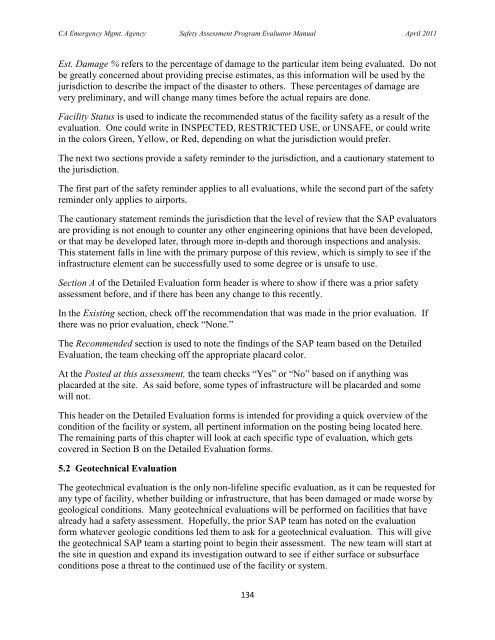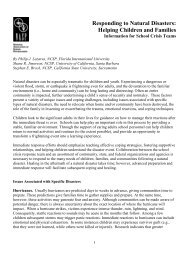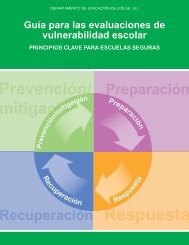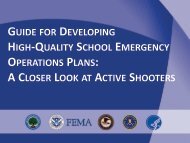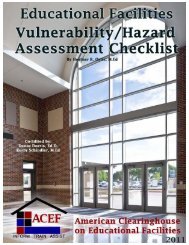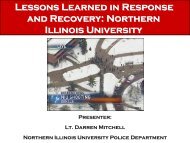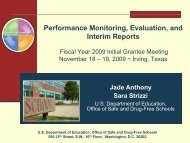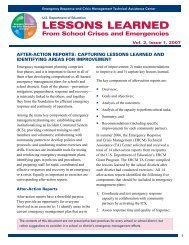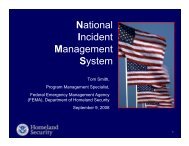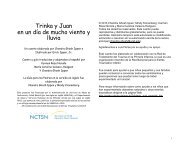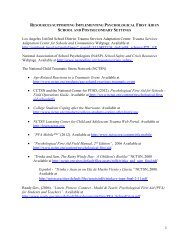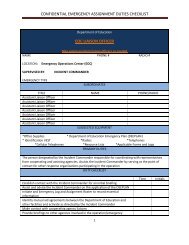Safety Assessment Program Evaluator Student Manual
Safety Assessment Program Evaluator Student Manual
Safety Assessment Program Evaluator Student Manual
You also want an ePaper? Increase the reach of your titles
YUMPU automatically turns print PDFs into web optimized ePapers that Google loves.
CA Emergency Mgmt. Agency <strong>Safety</strong> <strong>Assessment</strong> <strong>Program</strong> <strong>Evaluator</strong> <strong>Manual</strong> April 2011Est. Damage % refers to the percentage of damage to the particular item being evaluated. Do notbe greatly concerned about providing precise estimates, as this information will be used by thejurisdiction to describe the impact of the disaster to others. These percentages of damage arevery preliminary, and will change many times before the actual repairs are done.Facility Status is used to indicate the recommended status of the facility safety as a result of theevaluation. One could write in INSPECTED, RESTRICTED USE, or UNSAFE, or could writein the colors Green, Yellow, or Red, depending on what the jurisdiction would prefer.The next two sections provide a safety reminder to the jurisdiction, and a cautionary statement tothe jurisdiction.The first part of the safety reminder applies to all evaluations, while the second part of the safetyreminder only applies to airports.The cautionary statement reminds the jurisdiction that the level of review that the SAP evaluatorsare providing is not enough to counter any other engineering opinions that have been developed,or that may be developed later, through more in-depth and thorough inspections and analysis.This statement falls in line with the primary purpose of this review, which is simply to see if theinfrastructure element can be successfully used to some degree or is unsafe to use.Section A of the Detailed Evaluation form header is where to show if there was a prior safetyassessment before, and if there has been any change to this recently.In the Existing section, check off the recommendation that was made in the prior evaluation. Ifthere was no prior evaluation, check “None.”The Recommended section is used to note the findings of the SAP team based on the DetailedEvaluation, the team checking off the appropriate placard color.At the Posted at this assessment, the team checks “Yes” or “No” based on if anything wasplacarded at the site. As said before, some types of infrastructure will be placarded and somewill not.This header on the Detailed Evaluation forms is intended for providing a quick overview of thecondition of the facility or system, all pertinent information on the posting being located here.The remaining parts of this chapter will look at each specific type of evaluation, which getscovered in Section B on the Detailed Evaluation forms.5.2 Geotechnical EvaluationThe geotechnical evaluation is the only non-lifeline specific evaluation, as it can be requested forany type of facility, whether building or infrastructure, that has been damaged or made worse bygeological conditions. Many geotechnical evaluations will be performed on facilities that havealready had a safety assessment. Hopefully, the prior SAP team has noted on the evaluationform whatever geologic conditions led them to ask for a geotechnical evaluation. This will givethe geotechnical SAP team a starting point to begin their assessment. The new team will start atthe site in question and expand its investigation outward to see if either surface or subsurfaceconditions pose a threat to the continued use of the facility or system.134


